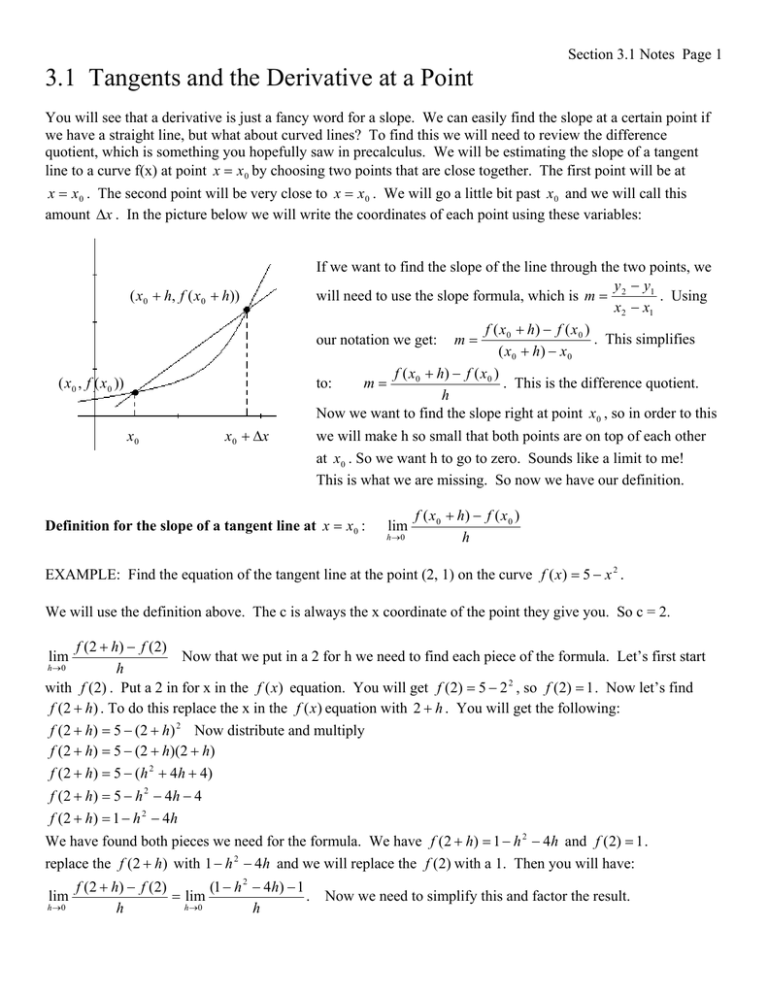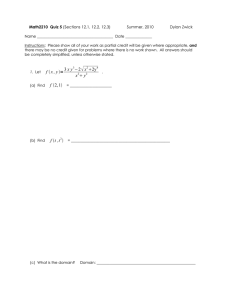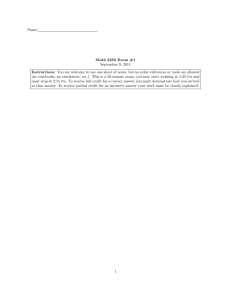3.1 Tangents and the Derivative at a Point
advertisement

Section 3.1 Notes Page 1 3.1 Tangents and the Derivative at a Point You will see that a derivative is just a fancy word for a slope. We can easily find the slope at a certain point if we have a straight line, but what about curved lines? To find this we will need to review the difference quotient, which is something you hopefully saw in precalculus. We will be estimating the slope of a tangent line to a curve f(x) at point x x 0 by choosing two points that are close together. The first point will be at x x 0 . The second point will be very close to x x 0 . We will go a little bit past x0 and we will call this amount x . In the picture below we will write the coordinates of each point using these variables: ( x 0 h, f ( x0 h)) ( x 0 , f ( x0 )) x0 x0 x If we want to find the slope of the line through the two points, we y y1 will need to use the slope formula, which is m 2 . Using x 2 x1 f ( x 0 h) f ( x 0 ) . This simplifies our notation we get: m ( x 0 h) x 0 f ( x 0 h) f ( x 0 ) m to: . This is the difference quotient. h Now we want to find the slope right at point x0 , so in order to this we will make h so small that both points are on top of each other at x0 . So we want h to go to zero. Sounds like a limit to me! This is what we are missing. So now we have our definition. Definition for the slope of a tangent line at x x 0 : lim h0 f ( x 0 h) f ( x 0 ) h EXAMPLE: Find the equation of the tangent line at the point (2, 1) on the curve f ( x) 5 x 2 . We will use the definition above. The c is always the x coordinate of the point they give you. So c = 2. f (2 h) f (2) Now that we put in a 2 for h we need to find each piece of the formula. Let’s first start h0 h with f (2) . Put a 2 in for x in the f (x) equation. You will get f (2) 5 2 2 , so f (2) 1 . Now let’s find f (2 h) . To do this replace the x in the f (x) equation with 2 h . You will get the following: f (2 h) 5 (2 h) 2 Now distribute and multiply f (2 h) 5 (2 h)(2 h) f (2 h) 5 (h 2 4h 4) f ( 2 h ) 5 h 2 4h 4 f ( 2 h) 1 h 2 4h We have found both pieces we need for the formula. We have f (2 h) 1 h 2 4h and f (2) 1 . replace the f (2 h) with 1 h 2 4h and we will replace the f (2) with a 1. Then you will have: lim lim h0 (1 h 2 4h) 1 f (2 h) f (2) lim . Now we need to simplify this and factor the result. h 0 h h Section 3.1 Notes Page 2 h 4h h(h 4) lim lim (h 4) . Now put in a 0 for h and you will get -4. h 0 h 0 h h 2 lim h0 So this means that the slope of the tangent line at x = 2 is -4. Now we need to find the equation of the tangent line. We will start with the equation y = mx + b. We will know that m = -4, x = 2, and y = 1. Plug these into the formula: 1 = -4(2) + b. Now solve for b. You will get b = 9. So our equation is y = -4x + 9. EXAMPLE: Find the equation of the tangent line at the point (-1, 4) on the curve g (t ) t 2 3 . So this time x0 1 . If we put that into the derivative formula and change the f(x) to g(t) we will get: lim h0 g (1 h) g (1) Now we will find g (1 h) and g (1) . We will get: h g (1) (1) 2 3 1 3 4 and we also have: g (1 h) (1 h) 2 3 (1 2h h 2 ) 3 4 2h h 2 . We will put these into the derivative formula: ( 4 2h h 2 ) 4 2h h 2 h(2 h) lim lim lim lim 2 h 4 0 2 . So the slope of tangent line h0 h 0 h 0 h 0 h h h to this curve at this point is -2. Now we need to find the equation of the tangent line. We will start with the equation y = mx + b. We will know that m = -2, x = -1, and y = 4. Plug these into the formula: 4 = -2(-1) + b. Now solve for b. You will get b = 2. So our equation is y = -2x + 2. EXAMPLE: Find the equation of the tangent line at the point (2, 2) on the curve f ( x) 8 . x2 So this time x0 2 . If we put that into the derivative formula we will get: lim h0 f (2 h) f (2) Now we will find f (2 h) and f (2) . We will get: h f (2) 8 (2) 2 2 and we also have: f (2 h) 8 (2 h) 2 . We will put these into the derivative formula: 8 2 8 2( 2 h ) 2 h ( 8 2 h ) 8 2(4 4h h 2 ) 8 8 8h 2 h 2 ( 2 h) 2 1 ( 2 h) 2 lim lim lim lim lim . So 2 2 h0 h 0 h 0 h0 h 0 h( 2 h) 2 h h h( 2 h) h( 2 h) (8 2h) 8 0 2 . So the slope of tangent line to this curve at this point is 2. Now we need to find lim h 0 ( 2 h) 2 (2 0) 2 the equation of the tangent line. We will start with the equation y = mx + b. We will know that m = -2, x = 2, and y = 2. Plug these into the formula: 2 = -2(2) + b. Now solve for b. You will get b = 6. So our equation is y = -2x + 6. Section 3.1 Notes Page 3 EXAMPLE: Find the equation of the tangent line at the point (8, 3) on the curve f ( x) x 1 . So this time x0 8 . If we put that into the derivative formula we will get: lim h0 f (8 h) f (8) Now we will find f (8 h) and f (8) . We will get: h f (8) 8 1 9 3 and we also have: f (8 h) 8 h 1 9 h . We will put these into the derivative formula: lim h0 9h 3 . Now in order to solve this one we need to multiply top and bottom by the conjugate. h 9h 3 9h 3 9h3 9h 3 9h 9 h 1 lim lim lim . Now put h 0 h 0 h 9 h 3 h 0 h 9 h 3 h 0 h 9h 3 9h 3 1 1 1 1 1 . in a zero for h to get: lim h0 9h 3 90 3 9 3 33 6 lim So the slope of tangent line to this curve at this point is 1/6. Now we need to find the equation of the tangent line. We will start with the equation y = mx + b. We will know that m = 1/6, x = 8 and y = 3. 1 4 Plug these into the formula: 3 (8) b . So this simplifies to 3 b . Now add the fraction to both 6 3 4 13 1 13 sides: 3 b . We will get b . So our equation is: y x . 3 3 6 3 EXAMPLE: Find the equation of the tangent line at the point (2, 4) on the curve y 2x . x 1 f (2 h) f (2) . Now we will h0 h 2(h 2) 2h 4 . We will put find f (2 h) and f (2) . We will get: f (2) 4 and we also have: f (h 2) h 2 1 h 1 these into the derivative formula. We want to get common denominators. When you do, you will be able to simplify: So this time x0 2 . If we put that into the derivative formula we will get: lim 2h 4 2h 4 4(h 1) 2h 4 4h 4 2h 4 2h 2 h 1 h 1 lim h 1 lim lim lim lim h 1 lim . h 0 h 0 h 0 h 0 h 0 h( h 1) h 0 ( h 1) h h h h 2 2 . So the slope of tangent line to this curve at this point h 0 (0 1) is 2 . We will start with the equation y = mx + b. We will know that m = –2, x = 2, and y = 4. Plug these into the formula: 4 2(2) b . Now solve for b. You will get b = 8. So our equation is y 2 x 8 . Now we just put in a zero for h to get: lim




